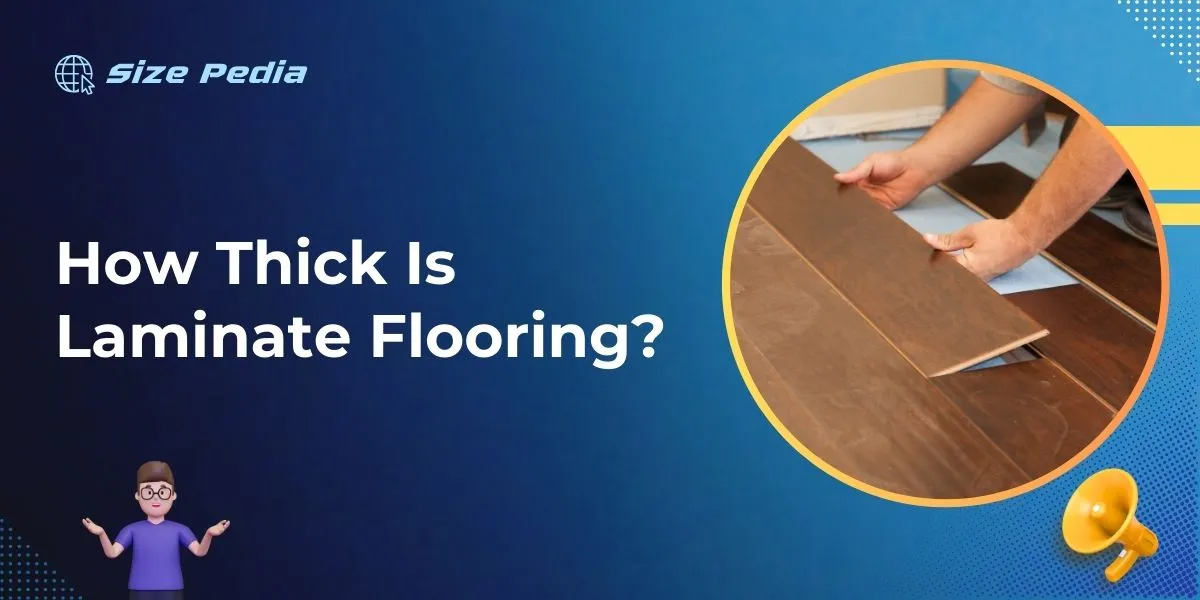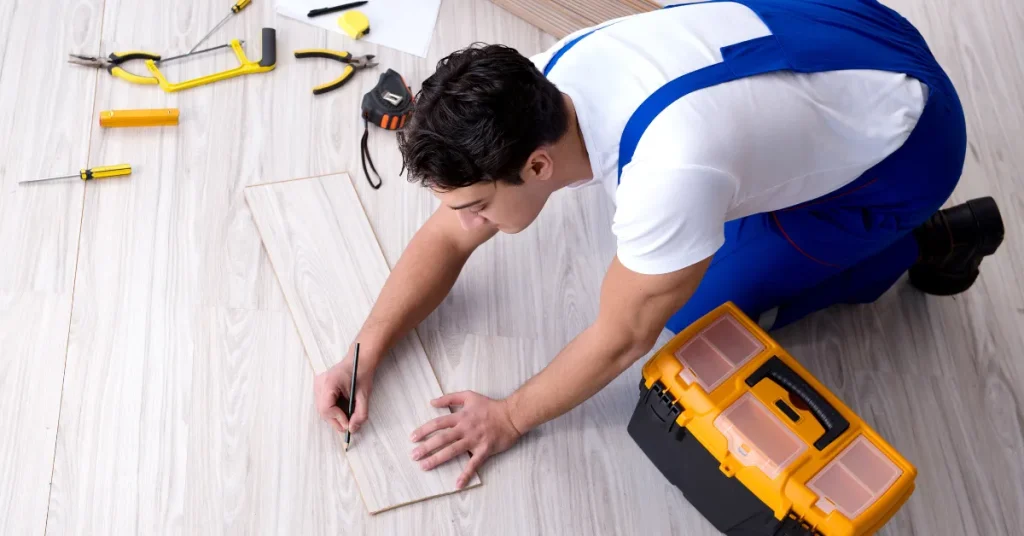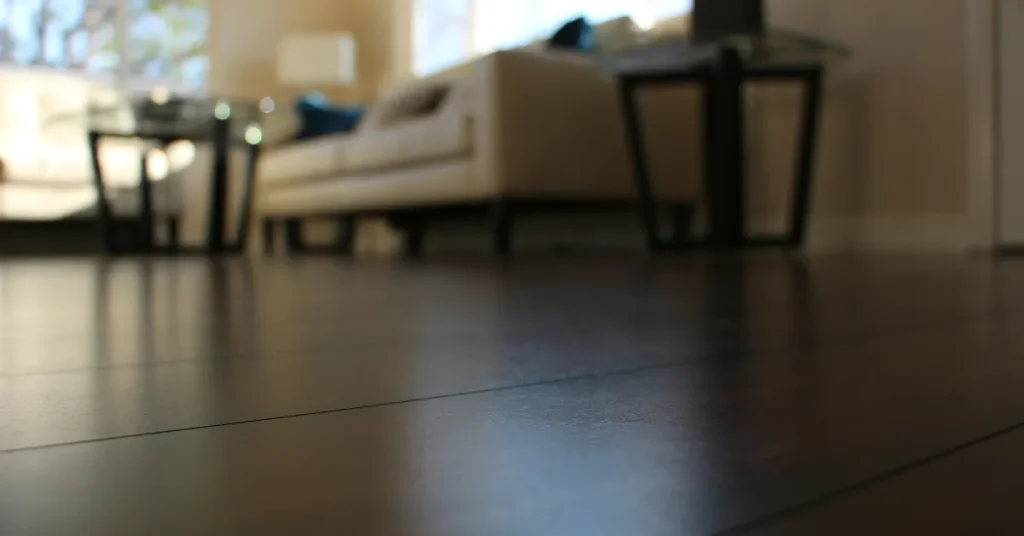Laminate flooring typically ranges from 6mm to 12mm in thickness. The variation in thickness allows for different levels of durability and sound insulation.
Laminate flooring has become a popular choice for homeowners seeking an affordable yet stylish flooring solution. Its durability often relates directly to its thickness, with thicker options offering better resistance to wear and tear.
Not only does thickness impact the feel and stability of the flooring underfoot, but it also plays a crucial role in how well the flooring can mask imperfections in the subfloor.
Those looking for a quick and relatively easy installation will find laminate a favorable option. Its versatility in design mimics the look of hardwood or stone floors, making it an attractive choice for various interior aesthetics.
The thickness you choose can affect both the cost and the performance of your flooring, making it an important consideration in your selection process.

The Essence Of Laminate Flooring Thickness
Laminate flooring revolutionizes homes with its versatility and style. Choosing the right thickness is crucial. It can affect several aspects of the flooring experience.
Homes benefit from the functional attributes tied to the thickness of laminate planks. Let’s delve into how this single measurement can impact durability and comfort.
Impact On Durability
Durability holds the key to a long-lasting floor. Thicker laminate can withstand more. It resists wear from foot traffic, dents, and scratches better than thinner options. Here is a breakdown of thickness categories:
- 6-7 mm: Ideal for light use areas
- 8-10 mm: Balances cost and resilience
- 10-12 mm: Offers professional-level endurance
Laminate’s core density increases with thickness. Thick planks promise longevity.
Influence On Comfort And Insulation
Thickness isn’t just about warding off damage. It affects how the floor feels and insulates. A thicker laminate floor feels more solid. It echoes less when walked on. The planks absorb more noise, creating a quieter home environment.
Regarding temperature, thick laminate provides better insulation. This keeps floors warm in winter. The table below summarizes the benefits:
| Thickness (mm) | Comfort | Insulation |
| 6-7 | Basic | Minimal |
| 8-10 | Enhanced | Moderate |
| 10-12 | Superior | Optimal |
Choosing thicker laminate can lead to increased comfort and energy savings. This makes it a practical choice for busy homes.
Common Thickness Measurements
Understanding the thickness of laminate flooring is key for durability and stability. It also affects how it feels underfoot and the level of acoustic insulation. Let’s dive into the core measurements that can guide your choice.
Entry-level Thickness Options
Starting simply, the entry-level laminate flooring represents the most affordable choices. These options usually measure:
- 6mm – Quite thin, best for areas with less foot traffic.
- 7mm – A step up in durability while still cost-effective.
- 8mm – Offers a basic level of comfort and noise reduction.
Mid-range Profiles
A balance of cost and quality, mid-range laminate options provide a more robust surface. These come in:
- 10mm – Better acoustics and a firmer feel underfoot.
- 12mm – Even greater stability and sound absorption.
Premium Thickness Varieties
For the ultimate experience in laminate flooring, premium options are the thickest. Exceptional in noise reduction and comfort, these include:
| Thickness | Benefits |
| 12mm | Superior feel and durability |
| 14mm | Top-of-the-line in acoustic performance |
Layered Makeup Of Laminate

Laminate flooring offers beauty and durability. It is like a sandwich. Each layer has a job. Together, they make floors both tough and pretty.
Wear Layer And Design
The top is the Wear Layer. It fights scratches and UV rays. It keeps the floor looking new. Under it is the Design Layer. It has a photo. This photo makes the floor look like wood or stone.
Core Layer
The Core Layer gives strength. It is thick and dense. It helps laminate stand up to foot traffic. It also helps with impacts from dropped items.
Backing Stability And Moisture Resistance
The Backing Layer protects from below. It stops moisture. It also keeps planks flat. This layer helps your floor last longer. It keeps away mold and warping.
Choosing The Right Thickness
When revamping your floors, laminate flooring thickness plays a crucial role. The durability, feel, and overall look of your floors depend on this single choice. Let’s delve into making the best selection for your home’s needs.
Assessing Your Usage Requirements
Laminate floors come in thicknesses ranging from 6mm to 12mm. Thicker options can withstand more use and have a longer life. Consider the following points:
- High traffic areas need thicker laminate for durability.
- For lighter use rooms, a thinner option may suffice.
- Children and pets might necessitate a thicker, more resistant choice.
Room And Subfloor Considerations
Before deciding on thickness, assess the room and its subfloor:
- Uneven subfloors require thicker laminate to hide imperfections.
- In areas with moisture concerns, thicker laminate can offer more stability.
- If the room is at ground level or below, opting for a thicker grade may help with insulation.
Aesthetic And Acoustic Concerns
Thicker laminate not only looks sturdier but also helps with sound dampening. Ensure your home looks and feels right by considering:
| Thickness | Acoustic Quality | Feel Underfoot |
| 6-7mm | Poorer | Firm |
| 8-10mm | Better | Softer |
| 10-12mm | Best | Very Soft |
Rooms with high echo benefit from thicker laminate. It provides a solid feel and reduces noise.
Installation Implications
Understanding the thickness of laminate flooring is crucial before installation. Different thicknesses have unique benefits and challenges. This section covers critical aspects of laminate flooring installation.
Preparation And Underlayment Necessities
Laminate flooring requires a solid base for optimal performance. Proper preparation ensures durability and comfort. Here’s what to consider:
- Subfloor Condition: The subfloor must be clean, level, and dry.
- Moisture Barrier: A necessity in moisture-prone areas to protect the laminate.
- Underlayment Type: Select based on room acoustics and insulation needs.
- Underlayment Thickness: Match with laminate thickness for stability.
Underlayment plays a role in noise reduction and comfort. This layer goes beneath your laminate. It can also help correct minor subfloor imperfections. Quality underlayment contributes to the lifespan of your flooring.
Transitioning Between Different Flooring Types
Transitions make a smooth switch from laminate to other flooring. Details to note include:
| Transition Type | Purpose |
| T-Molding | Separates flooring of the same height |
| Reducer Strip | Connects laminate to lower flooring |
| Stair Nosing | Finishes edges on stairs or landings |
The right transition piece ensures a seamless floor appearance. They also address potential trip hazards. When installing laminate, remember to leave expansion gaps. These gaps prevent buckling as floors naturally expand and contract.
Maintaining Your Laminate’s Look And Feel

Laminate flooring offers beauty and durability that, with proper care, can last for years. It mirrors the elegance of hardwood without the cost.
Making sure it carries that fresh, vibrant look requires specific attention though. Read on to explore the best ways to keep your laminate flooring in top-notch condition.
Cleaning Practices
Dirt and dust can scratch the laminate’s surface over time. Regular sweeping with a soft-bristle broom or vacuuming with a hardwood floor attachment is vital.
Mop your floor using a damp cloth or microfiber mop with a laminate-approved cleaner; less moisture means no warping or damage.
- Avoid excess water which can cause swelling.
- Never use wax, polish, or abrasive cleaners.
- Clean spills immediately to prevent staining.
Managing Wear And Tear
Even the toughest floors face wear and tear. Preventive measures can go a long way. Use protective pads under furniture and mats at entrances to catch grit. For pet owners, trimming nails will minimize scratches.
- Place rugs in high-traffic areas.
- Lift rather than drag furniture when moving it.
- Keep blinds or curtains closed during peak sunlight hours to prevent fading.
Regular attention and the right methods will keep your laminate flooring resilient and stunning.
Simple steps can extend its lifespan and maintain its allure, ensuring your home stays as elegant as the day the flooring was laid.
FAQs About How Thick Is Laminate Flooring
How Thick Is Laminate Flooring In Inches?
Laminate flooring typically ranges from 1/4 inch to 1/2 inch in thickness.
What Thickness Laminate Flooring Is Best?
The best thickness for laminate flooring is generally 8 to 12mm. Thicker laminate provides better sound insulation and feels more like hardwood underfoot.
Is Laminate Flooring Thicker Than Vinyl Plank?
Laminate flooring is generally thicker than vinyl plank, offering more robustness and a solid feel underfoot. Vinyl planks tend to be thinner with a focus on flexibility and water resistance.
How Thick Is Laminate Flooring With Underlay?
Laminate flooring with underlay typically measures between 6mm to 12mm in thickness. The underlay adds an extra 1mm to 3mm, depending on the type.
Conclusion
Understanding laminate flooring thickness is essential for any flooring project. It impacts durability, comfort, and aesthetics.
Our guide has outlined the various thicknesses available, from 6 mm to 12 mm, to help you make an informed decision. Remember, the right choice hinges on your specific needs and room requirements.
Choose wisely for a lasting, beautiful finish to your space.
Resources:
1. https://www.epa.gov/formaldehyde/questions-and-answers-regarding-laminate-flooring
